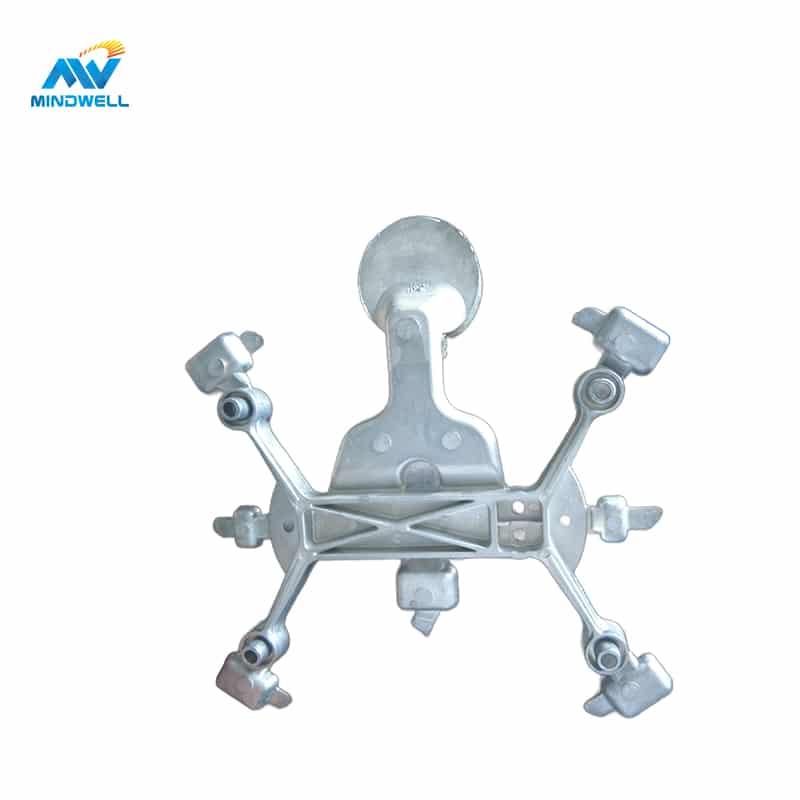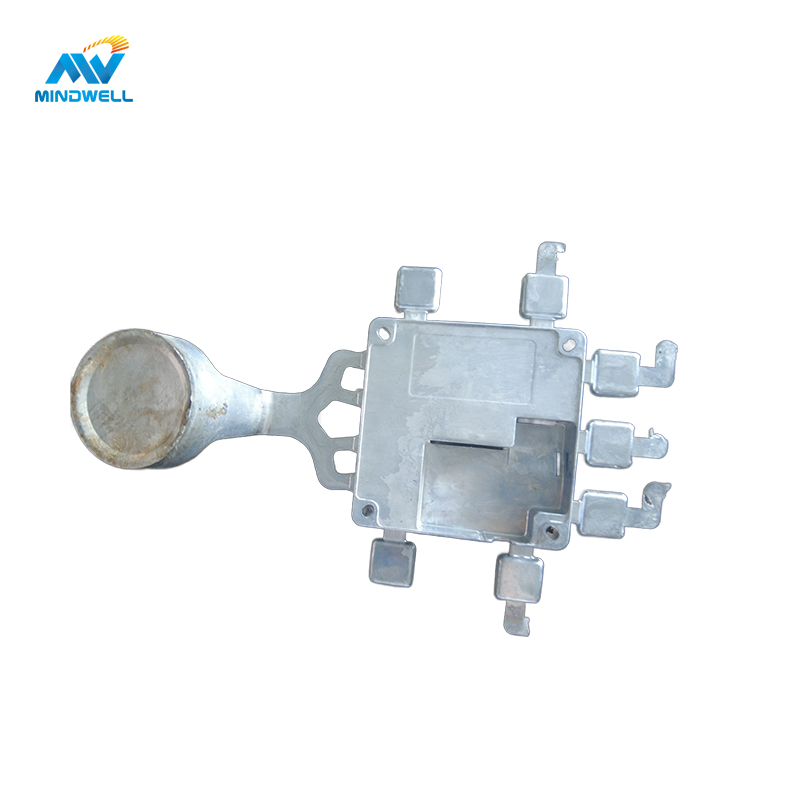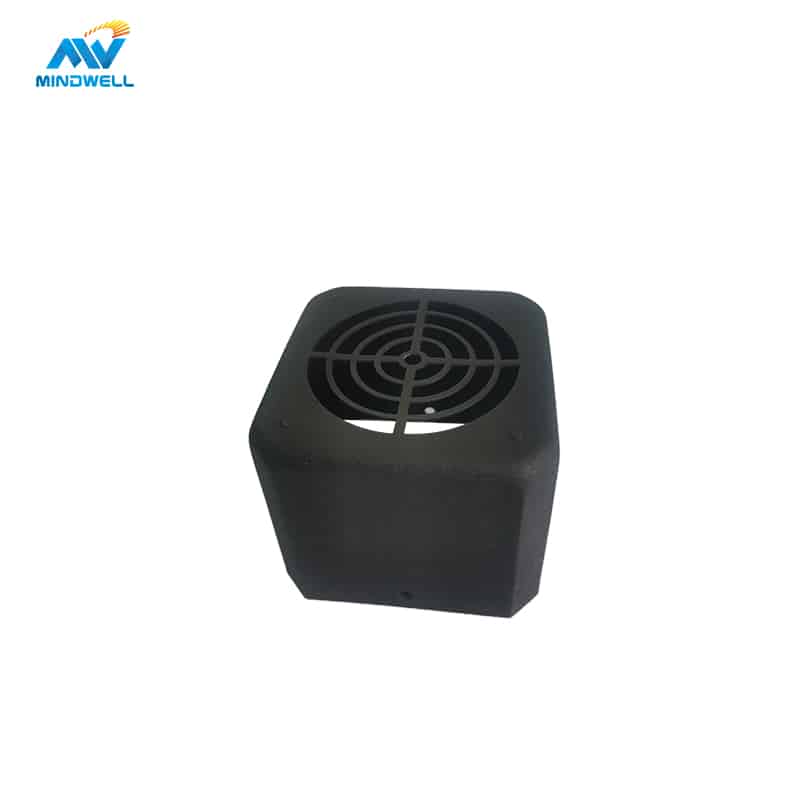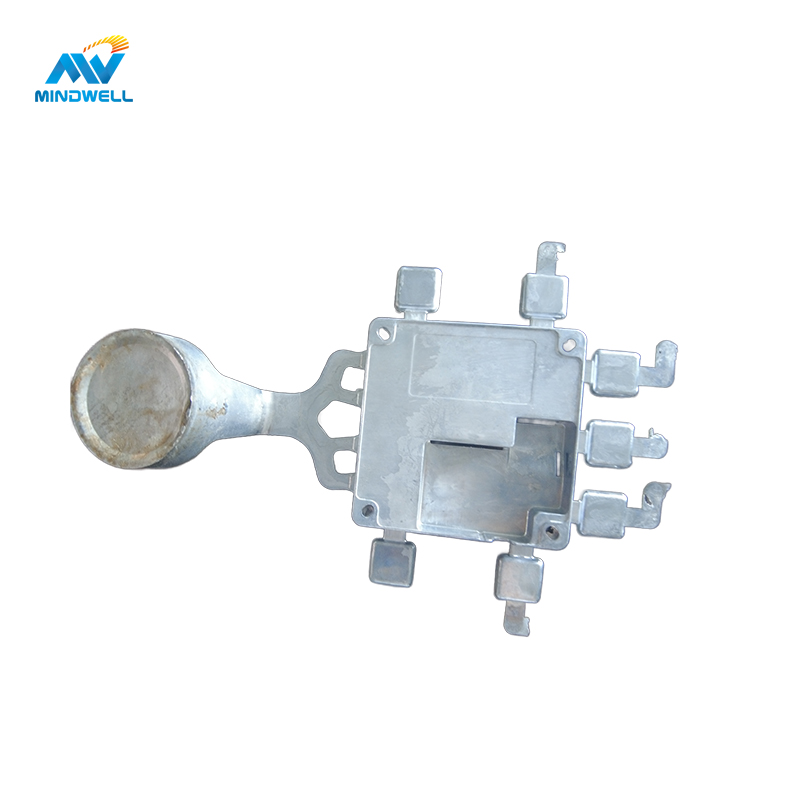A very effective and adaptable production technique, high-pressure aluminum die casting is used to precisely create complex and detailed aluminum components. Because it can produce intricate forms, precise tolerances, and high-quality end products, this technology has become more popular in a variety of sectors. The principles, benefits, and uses of high-pressure aluminum die casting will all be covered in this article.
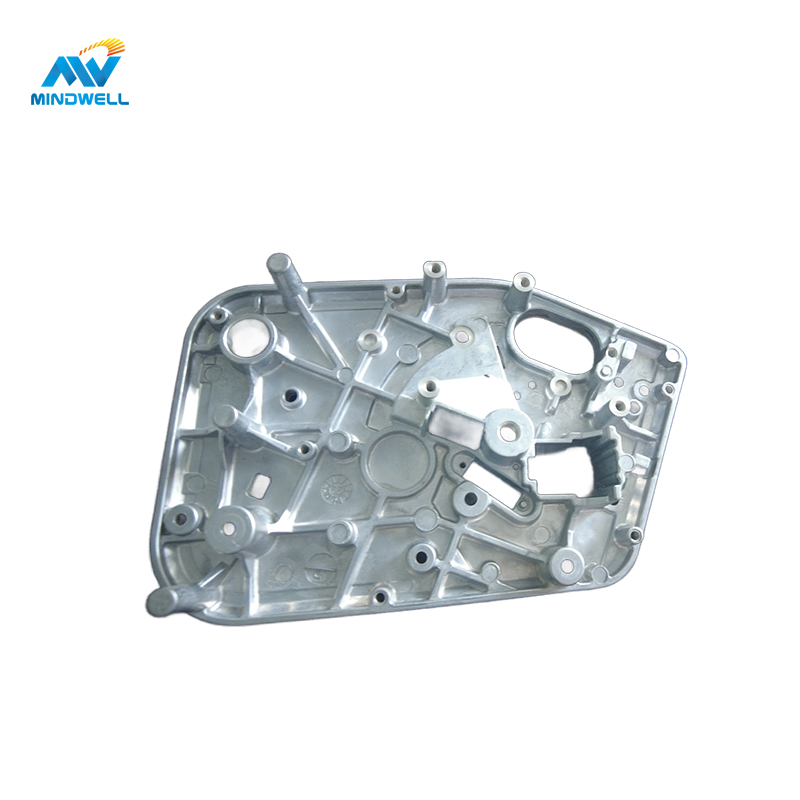
what is high-pressure aluminum die casting process?
A sophisticated manufacturing technique called high-pressure aluminum die casting is utilized to precisely create complex and detailed metal components. In order to create intricate forms and precise tolerances, molten aluminum is injected under high pressure into a mold cavity. Preparing the mold, injecting the molten aluminum, cooling and solidifying, and ejecting the casting are the essential steps in the high-pressure aluminum die casting process.
The primary characteristic of high-pressure aluminum die-casting is its high injection pressure and speed, which enable the metal to swiftly fill the mold’s corners and produce pieces with a high degree of accuracy and density. The majority of high-pressure die castings don’t need to be deburred, drilled, or tapped once they are produced.
Furthermore, since aluminum is very strong and light, high-pressure aluminum die castings may take the place of some steel in a product, lowering its total weight without sacrificing its strength.
High-Pressure Aluminum Die Casting Process:
Mold Readying:
The first step in the procedure is to create a metallic mold in the form of the required component. This mold is usually made of steel or iron. The high pressure and temperature involved in the casting process are intended to be tolerated by the mold.
Aluminum molten is injected.
Aluminum is melted in a furnace and then poured into the mold at a very high pressure, often between 1500 and 25,000 psi (pounds per square inch). Aluminum may also be recycled. This high pressure guarantees that the metal melts fully into the mold cavities.
The process of cooling and solidification.
The molten aluminum is allowed to cool and solidify after filling the mold, taking on the form of the mold during this process. To assure the correct material qualities and avoid faults, the cooling process is meticulously regulated.
Removal from the casting:
The freshly formed aluminum component is released from the mold after it has solidified. After that, the mold may be used again for more castings.
How does the high-pressure die casting process work?
- After being heated to its melting point, molten metal turns into a liquid.
- High pressure is used throughout the die-casting process to quickly force liquid metal into the precise metal mold cavity.
- The molten metal cools and solidifies under pressure to create the desired casting.
- Open the die-casting mold, remove the casting, and finish the die-casting process after the liquid metal has set fully.
The two fundamental techniques for producing high-pressure aluminum die casting are cold chamber die casting and hot chamber die casting. Melted metal is poured into the pressure chamber of a cold chamber die casting machine using a manual or automated pouring system. The metal is then hydraulically forced into the mold cavity by the injection punch as it advances. The pressure chamber in the hot chamber die-casting method is positioned perpendicular to the crucible. Melted metal enters the pressure chamber automatically via the feed port, and the injection punch descends to force the molten metal into the mold cavity.
Advantages of High-Pressure Aluminum Die Casting:
- High accuracy and density: High-pressure injection may guarantee high precision and density in aluminum castings, resulting in higher-quality products.
- Ideal for massive castings made of aluminum: big aluminum castings may be produced using the high-pressure aluminum die-casting technique, which makes it perfect for use in big industrial applications.
- High production efficiency: Aluminum die-casting can constantly make large numbers of items and increase production efficiency because it can solidify fast under high pressure to form the required product.
- Minimal production costs: The method of aluminum die-casting involves injecting molten metal into a mold, which quickly solidifies under high pressure to create the desired result. The production cost is inexpensive because this technology can create vast numbers of tiny and medium-sized components while conserving a lot of energy and resources.
- High manufacturing accuracy: The precision of manufactured goods may approach millimeter levels since high-pressure aluminum die-casting is produced in a completely automated manner.
- Stable product quality: Technology for processing aluminum die-casting may eliminate manual labor and prevent issues with product quality brought on by human factors. Simultaneously, every step of the manufacturing process, including the choice of raw materials, ensures that the goods are of the highest caliber.
- Aluminum die-casting has a fast cycle time and great production efficiency when compared to other manufacturing methods. In most cases, the whole process, from product design to manufacturing, takes just a few weeks. The enterprise’s production efficiency may be significantly increased by this quick manufacturing cycle.
- High plasticity: Products of a variety of forms may be produced using the die-casting process of aluminum. Furthermore, precise aluminum die-casting can satisfy the various industries’ demands for product shapes due to aluminum’s high plasticity.
- Environmental protection and energy conservation: The manufacturing method of aluminum die-casting uses molten aluminum alloy instead of hazardous solvents, adhesives, or other chemicals, which satisfies both environmental and energy conservation standards. In order to accomplish resource recycling and lower manufacturing costs, waste aluminum may also be recycled while the product is being made.
High Pressure vs Low Pressure Aluminum Die Casting
Aluminum and other metals are cast using two different processes: high-pressure die casting (HPDC) and low-pressure die casting (LPDC). The pressure used during the casting process is where these techniques diverge most.
High-pressure die casting (HPDC):
Process:
- In HPDC, molten metal is injected at high speed and pressure into a metal mold cavity.
- The high pressure is maintained throughout the solidification process to ensure the formation of detailed and precise castings.
Pressure:
Typically, high-pressure die casting involves pressures ranging from 10,000 to 30,000 psi (70 to 200 MPa).
장점:
- High production rates: HPDC is known for its ability to produce large quantities of complex, high-integrity parts quickly.
- Excellent dimensional accuracy and surface finish.
- Suitable for thin-walled and intricate designs.
Disadvantages:
- Equipment costs can be relatively high.
- Tooling costs are significant.
- Limited to smaller casting sizes compared to low-pressure processes.
Die Casting at Low Pressure (LPDC):
Method:
Melted metal is poured into the mold using a regulated low-pressure mechanism in LPDC.
Usually, throughout the casting process, the pressure is kept at a lower level.
Apply pressure:
Generally speaking, LPDC operates at lower pressures, between a few hundred and several thousand psi (about 0.07 and 3 MPa).
Benefits
- less expensive tools and equipment than high-pressure procedures.
- Ideal for bigger, more substantial castings.
- Reduced turbulence in the molten metal may lead to a decrease in the number of gas porosities.
Drawbacks:
- lower output rates in contrast to die casting at high pressure.
- may not be able to achieve elements that are really complex and elaborate.
A number of variables, including the part’s size and complexity, production volume, financial concerns, and necessary material qualities, must be taken into account when deciding between high-pressure and low-pressure die casting. Low-pressure die casting could be more appropriate for bigger, simpler parts with lower production quantities, whereas high-pressure die casting is often used for high-volume manufacturing of smaller, intricate components. The choice of procedure is contingent upon the particular demands of the casting project, since each method has a unique combination of benefits and drawbacks.
Why is aluminum material suitable for high-pressure die casting?
The reasons why aluminum materials are suitable for high-pressure die-casting are as follows:
- Low melting point: Aluminum has a relatively low melting point, about 660°C, which makes it easy to melt and inject into molds under high pressure.
- Good fluidity: Aluminum has good fluidity and can be smoothly injected into fine parts of the mold under high pressure to obtain a complete product.
- Good corrosion resistance: Aluminum is a corrosion-resistant material that does not easily react with oxygen, carbon dioxide, water, and other substances in the air, so it can maintain its performance and appearance for a long time.
- Moderate density: The density of aluminum is relatively low, about 2.7 g/cm2, which means aluminum products are lightweight and easy to transport and use.
- Recyclable: Aluminum is a recyclable material that meets the requirements of sustainable development.
- To sum up, the reason why aluminum material is suitable for high-pressure die-casting is mainly due to its low melting point, good fluidity, good corrosion resistance, moderate density and recyclability.
High-Pressure Aluminum Die Casting Applications:
자동차 부문:
Automobile structural elements, engine components, and gearbox cases benefit from high-pressure die-cast aluminum’s strength and lightweight qualities.
소비자용 전자 제품:
This method is often used to create housings for complex components such as heat sinks and electrical gadgets.
Airspace:
High-pressure die-cast aluminum is lightweight and strong, making it a great choice for a variety of aviation components, including housings and structural sections.
Engineering in general:
A large variety of components for tools, machinery, and industrial equipment may be produced because to the process’s adaptability.
A popular and effective technique for creating aluminum components that satisfy industrial requirements and high quality standards is high-pressure aluminum die casting. Because of its capacity to create intricate forms and preserve dimensional precision, it is essential to the production of many goods in a variety of industries.
Conclusion:
High-pressure aluminum die casting is a sophisticated and efficient manufacturing process that has revolutionized the production of complex aluminum components. Its ability to achieve high precision, cost-effectiveness, and versatility makes it a preferred choice across diverse industries, driving innovation and advancements in product design and manufacturing. As technology continues to evolve, high-pressure aluminum die casting is likely to play a crucial role in shaping the future of manufacturing.
What are 3 limitations of high pressure die casting?
High-pressure die casting (HPDC) has several drawbacks in addition to its numerous benefits. The following three main restrictions apply to high-pressure die casting:
Costs of tooling:
For high-pressure die casting, the initial tooling costs might be somewhat substantial. It takes a lot of money to create the molds, or die tooling, that are used to shape and form the molten metal. The complexity and expense of their manufacturing are increased by the molds’ need to endure high pressures and temperatures. Tooling expenses may be a big issue, especially when developing prototypes or limited production runs.
Limited Choice of Alloys:
Alloys that exhibit excellent fluidity and castability at elevated temperatures are often suitable candidates for high-pressure die casting. Due to their advantageous qualities, aluminum and zinc are often employed in HPDC; nevertheless, certain alloys that have poor castability or are prone to porosity at high pressures may not be as well suited for the process. Certain specific alloys could require different casting techniques or adjustments to the process parameters.
Limitations on Part Size:
Smaller to medium-sized components are often better suited for high-pressure die casting. The size and weight of the pieces that can be produced efficiently may be restricted by the machinery and equipment employed in the process. It might be difficult to cast larger, heavier components using high-pressure die casting methods. Other casting techniques, including sand casting or low-pressure die casting, can be better suited for bigger pieces.
It’s crucial to remember that high-pressure die casting is still appropriate for many applications despite these drawbacks. The method is still very useful for producing a variety of components, especially those that need to be produced in huge numbers with a high degree of accuracy and complexity. However, while choosing a casting technique for a particular project, designers and manufacturers should carefully analyze these limits and assess if high-pressure die casting fits with their needs and limitations.
What are the pressures for die casting?
Die casting is a process that creates intricate and precise objects by forcing molten metal under great pressure into a mold chamber. One important factor influencing the speed, integrity, and quality of the casting process is the pressure applied during the die casting process. The material being cast, the size and complexity of the component, and the particular die casting technique (e.g., high-pressure die casting or low-pressure die casting) may all affect the required pressure. The following are typical pressure ranges for several die casting types:
High-Pressure Die Casting (HPDC):
The pressure range often used in high-pressure die casting is 10,000 to 30,000 psi (70 to 200 MPa).
During the injection step, considerable pressure is used to guarantee that the molten metal fills the mold cavity fully and quickly.
Low-Pressure Die Casting (LPDC):
In contrast to high-pressure die casting, low-pressure die casting employs lower pressures.
Generally speaking, pressures in LPDC vary from a few hundred to a few thousand psi (or from 0.07 to 3 MPa).
Throughout the casting process, the lower pressure is maintained, enabling a slower, more deliberate fill of the mold.
Gravity Die Casting:
Melted metal is poured into the mold using gravity in gravity die casting, rather than using a lot of external pressure.
The height at which the molten metal is poured determines the pressure in gravity die casting, which is much lower than in high-pressure die casting.
It’s crucial to remember that the precise pressure needs might change depending on the alloy being cast, the part’s design, and the casting apparatus used. In order to achieve full mold filling, reduce errors, and guarantee the manufacture of castings of superior quality, pressure is an essential element.
The pressure numbers shown here are just suggestions; the actual pressures used in die casting may vary according to the particular needs of the project and the equipment’s capacity. In order to achieve the intended outcomes, casting process optimization requires careful consideration of these characteristics by designers and manufacturers.
Why does high pressure die casting?
For the manufacturing of intricate metal components, high-pressure die casting (HPDC) is used for a number of reasons, chief among them being the benefits it provides in terms of effectiveness, accuracy, and affordability. Here are several main justifications for the widespread usage of high-pressure die casting:
Quick Production:
High-pressure die casting makes it possible to produce intricate pieces quickly and precisely in huge numbers.
The method allows for quick cycle times, which makes it appropriate for large-scale production.
intricate geometries:
For casting complicated, detailed forms with precise features, HPDC is a good fit.
High pressure is used throughout the casting process to guarantee that molten metal fills complex mold cavities, resulting in components with fine details and tight tolerances.
Dimensional Precision:
Excellent dimensional precision and reproducibility are the outcome of maintaining a high pressure during the whole solidification process.
High-pressure die-casting components usually don’t need much further machining.
Slender Walled Areas:
Lightweight components and thin-walled sections may be produced using high-pressure die casting without compromising structural integrity.
Because of this, the procedure may be used in situations when losing weight is essential.
뛰어난 자료 무결성:
The cast pieces’ material integrity is improved and porosity is reduced thanks to the high pressure.
Better mechanical qualities, such increased strength and enhanced surface polish, are the outcome of this.
Economical for Large Volumes:
Large production runs make high-pressure die casting cost-effective, despite the potentially expensive initial tooling costs.
The low amount of post-casting machining and high production rates add to the overall cost effectiveness.
Versatility of Alloy:
High-pressure die casting is a flexible process that works with a variety of alloys, the most popular ones being zinc and aluminum.
This makes it possible to choose materials with flexibility in accordance with certain performance criteria.
Diminished Waste:
Reduced scrap and material waste are a result of the die casting process’s great accuracy and control.
The need for extra material reduction is reduced when near-net-shape components may be produced.
Even though high-pressure die casting has several benefits, it’s important to take the particular needs of a given application into account. When selecting the best casting technique, consideration should be given to elements including component size, complexity, production volume, and material qualities.
What type of aluminum is used for die casting?
Good mechanical qualities, outstanding castability, and resistance to the high pressures and temperatures needed in the die casting process define aluminum alloys that are often used in die casting. The following aluminum alloys are most often used in die casting:
1. Aluminum Alloy 380 (A380):
One of the most popular alloys of aluminum for die casting is A380.
It has excellent machining and casting qualities.
Because of its exceptional fluidity, the A380 is a good choice for manufacturing intricate components with thin walls.
2. Aluminum Alloy 383 (A383):
A383 and A380 are comparable, while A383 has better resistance to heat cracking.
It is very useful for die casting complex components because of its increased fluidity.
3. Aluminum Alloy 360 (A360):
High strength, superior resistance to corrosion, and exceptional pressure tightness are attributes of A360.
It is often used for items that need to be machined as well as cast.
4. Aluminum Alloy 413 (A413):
Excellent fluidity and pressure tightness are provided by A413.
It is often applied to components that need to be very durable and resistant to corrosion.
5.Aluminum Alloy 390 (A390):
Excellent corrosion resistance and pressure tightness are two of A390’s best qualities.
It is often used in applications needing high-performance qualities, such as automobile components.
6. Aluminum Alloy 356 (A356):
The popular aluminum-silicon alloy A356 is renowned for its excellent casting qualities and thermal treatability.
It provides an excellent balance of corrosion resistance, ductility, and strength.
7. Aluminum Alloy 319 (A319):
When applications call for more fluidity and pressure tightness than some other alloys, A319 is often used.
The requirements of the application, which include elements like mechanical qualities, corrosion resistance, thermal conductivity, and economic considerations, determine which particular aluminum alloy is best for die casting. Depending on how these qualities need to be balanced for a given part or application, several alloys may be used. It’s also important to remember that new aluminum alloys may eventually be used in die casting applications as a result of developments in die casting technology and alloy development.
What is the difference between die casting and high pressure die casting?
Although die casting and high-pressure die casting are similar techniques, they are often used synonymously. There is a little difference between the two, however. Let’s explain the distinction:
Die Casting:
Definition: The technique of pumping molten metal into a mold, or die, to create a particular form or component is known as die casting.
Alternatives: Depending on the pressure used during the casting process, die casting may be roughly divided into several categories. These variations include gravity die casting, low-pressure die casting, and high-pressure die casting.
Pressure Range: Generally speaking, die casting may entail a variety of pressures. There are variations for both high and low pressures.
High-Pressure Die Casting (HPDC):
Definition: The method of die casting in which molten metal is pumped into a mold at high pressures is known as high-pressure die casting.
Features: During the injection phase of an HPDC, pressures usually vary from 10,000 to 30,000 psi (70 to 200 MPa).
Benefits: HPDC is renowned for its quick turnaround times on intricate, high-precision products with superior surface polish and dimensional accuracy.
Materials: often used for alloys made of zinc and aluminum.
To sum up, not all die casting is high-pressure die casting; nonetheless, all die casting is die casting. The phrase “die casting” refers to a group of procedures that include the injection of molten metal into a mold, sometimes at different pressures. High-pressure die casting is a subclass of die casting that focuses on using high injection pressures to obtain certain benefits including high material integrity, quick manufacturing, and complex component geometries.


